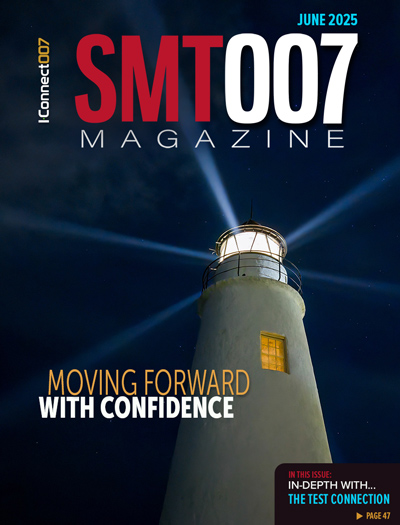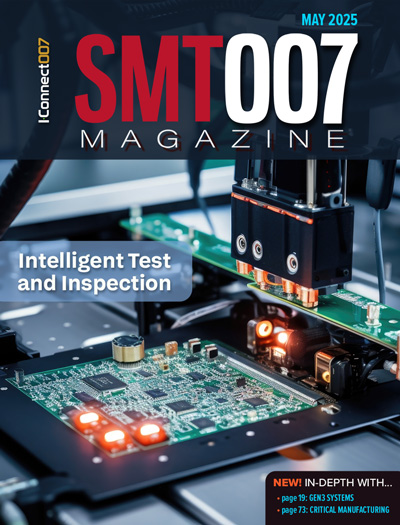-

- News
- Books
Featured Books
- smt007 Magazine
Latest Issues
Current Issue
What's Your Sweet Spot?
Are you in a niche that’s growing or shrinking? Is it time to reassess and refocus? We spotlight companies thriving by redefining or reinforcing their niche. What are their insights?

Moving Forward With Confidence
In this issue, we focus on sales and quoting, workforce training, new IPC leadership in the U.S. and Canada, the effects of tariffs, CFX standards, and much more—all designed to provide perspective as you move through the cloud bank of today's shifting economic market.

Intelligent Test and Inspection
Are you ready to explore the cutting-edge advancements shaping the electronics manufacturing industry? The May 2025 issue of SMT007 Magazine is packed with insights, innovations, and expert perspectives that you won’t want to miss.
- Articles
- Columns
- Links
- Media kit
||| MENU - smt007 Magazine
IPC Panel on Bottom-terminated Components
September 27, 2019 | Andy Shaughnessy, I-Connect007Estimated reading time: 7 minutes
During the IPC Summer Meetings in Raleigh, North Carolina, I sat down with Tom Rovere, a materials and process engineer at Lockheed Martin in Owego, New York. We explored a panel discussion on bottom-terminated components (BTCs) that Tom participated in as well as the challenges and issues related to BTCs and the important role that designers play in that process.
Andy Shaughnessy: Tom, it’s nice to meet you. You were on the BTC panel this morning, which was pretty interesting. Can you give us some background on yourself and how you acquired such a cool bio that says you know all about BTCs?
Tom Rovere: Looking back, I graduated from college with a material science and engineering degree. Then, I moved to Owego, New York, and started working at Lockheed. At that point, I didn’t have any experience with electronics assembly. I was lucky to have some great mentors, and over the past 10+ years of working on the manufacturing line, I’ve learned a great deal about ball grid arrays (BGAs), surface-mount technology, and bottom-terminated components. Over time, you use IPC standards, so I figured that I should start attending some of the IPC conferences. Most recently, I wanted to get more involved, so I kindly emailed the IPC Conference Manager and said, “Put me on a panel!” That’s how I got this opportunity.
Shaughnessy: It was a great panel. Everyone agreed that BTCs are very robust; they’re bulletproof, etc., but they have problems too. We know the pros, but can you talk about some of the cons?
Rovere: My expertise with BTCs is more related to the solder joint reliability and rework. We also had Dave Hillman, who’s probably one of the best industry experts to have on a panel with regards to BTCs and soldering. It was nice having him there because he answered a lot of the questions, and I could sit and nod my head in agreement. The assembly and reflow portion seems to be fairly robust. With mechanical reliability, voiding also doesn’t seem to be an issue either, according to Dave’s data.
Now, we’ve started to look back and think, “What about the cleanliness of these?” With such a low-profile part, it’s not as easy to get cleaning solution into those crevices and under those parts to get residual material out. We joked, saying that one option is to stop using flux, but you can’t do that yet. So, you’re stuck with flux or the byproduct of whatever is left after the soldering process, and you have to get that out. That’s one of the bigger challenges with low-profile parts, such as BTCs.
Now, there are design changes to improve cleanliness. One example we’ve talked about is removing the masking underneath. But at the same time, there’s a trade-off. Removing the masking could potentially create solder bridges underneath the component. When manufacturing, I would rather not remove that masking because it creates a different defect, one that may be more difficult to fix.
Shaughnessy: That’s one of the things where everybody blames or credits the designer, depending on if things go well or poorly. But there were certain things designers can do, like removing the solder mask, as you mentioned.
Rovere: Yes, and there are other issues with those parts as well; a lot of information is run through them, and they tend to get fairly hot on the board, which requires a lot of cooling. The parts are typically cooled through the board with the bottom termination. Unfortunately, since this termination is underneath the part, it’s tough to see an issue before it actually happens.
Shaughnessy: You said that designers would come to you and say, “Well, this one burned up!” And that’s how they know it failed?
Rovere: Right, they’ll say, “This one fried, so we need to take it off and put it back on.” By that time, it’s too late to do any failure analysis.” I wanted to know what the other panelists thought, so even though I was on the panel, I was almost part of the audience because I was interested in learning more and asked the other panelists questions too. For example, I asked, “Is there anything else we can do testing-wise to isolate these issues and screen out these parts before they burn up, and we have to replace them?”
Shaughnessy: Someone pointed out that the designer could play a big part in BTCs.
Rovere: Sometimes, designers need something that manufacturers would not prefer, but if it’s necessary, you have to reach a compromise. A designer might say that the ground pad underneath the BTC must have several vias in it to improve cooling. A manufacturer might ask, “Can we fill those vias with epoxy and plate over them? This will limit potential voiding, but it costs a little bit more money. That’s the compromise you have to make for a better surface underneath, so you don’t lose all of your solder down the vias.” Again, there’s a trade-off between cost, manufacturing, and design.
Page 1 of 2
Testimonial
"We’re proud to call I-Connect007 a trusted partner. Their innovative approach and industry insight made our podcast collaboration a success by connecting us with the right audience and delivering real results."
Julia McCaffrey - NCAB GroupSuggested Items
Weller Tools Supports Future Talent with Exclusive Donation to SMTA Michigan Student Soldering Competition
07/23/2025 | Weller ToolsWeller Tools, the industry leader in hand soldering solutions, is proud to announce its support of the upcoming SMTA Michigan Expo & Tech Forum by donating a limited-edition 80th Anniversary Black Soldering Set to the event’s student soldering competition.
Koh Young Appoints Tom Hattori as President of Koh Young Japan
07/21/2025 | Koh YoungKoh Young Technology, the global leader in True 3D measurement-based inspection solutions, announced the appointment of Tom Hattori as President of Koh Young Japan (JKY).
Silicon Mountain Contract Services Enhances SMT Capabilities with New HELLER Reflow Oven
07/17/2025 | Silicon Mountain Contract ServicesSilicon Mountain Contract Services, a leading provider of custom electronics manufacturing solutions, is proud to announce a significant upgrade to its SMT production capability with the addition of a HELLER 2043 MK5 10‑zone reflow oven to its Nampa facility.
Knocking Down the Bone Pile: Addressing End-of-life Component Solderability Issues, Part 4
07/16/2025 | Nash Bell -- Column: Knocking Down the Bone PileIn 1983, the Department of Defense identified that over 40% of military electronic system failures in the field were electrical, with approximately 50% attributed to poor solder connections. Investigations revealed that plated finishes, typically nickel or tin, were porous and non-intermetallic.
SHENMAO Strengthens Semiconductor Capabilities with Acquisition of PMTC
07/10/2025 | SHENMAOSHENMAO America, Inc. has announced the acquisition of Profound Material Technology Co., Ltd. (PMTC), a premier Taiwan-based manufacturer of high-performance solder balls for semiconductor packaging.


